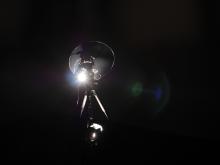Acoustic Scan is a research project exploring the concept of aural architecture using ultrasonic sound beams.
The first iteration of this project was presented at the Fase 6.0 Arts, Science and Technology Festival in Buenos Aires, Argentina, on October 25, 2014. For this performance a set of three ultrasonic speakers controlled by a robotic system was used to acoustically scan the architecture of the Paseo del Tilo of the Centro Cultural Recoleta.
Acoustic Scan II was presented as part of the Seattle Arts and Technology Meetup on February 18, 2015. This iteration consisted of three ultrasonic speakers installed on the floor and ceiling, drawing sound paths around the space which visitors could freely explore.
Description
Acoustic Scan is an iterative series of sound installations which engage the concept of aural architecture using highly directional sound beams. The work consists of an intervention into existing spaces, mapping a dynamic network of sound paths and reflections off the objects and walls of existing architecture. Robotic systems steer ultrasonic speakers to “scan” the walls, ceilings, and corners of rooms and passageways, revealing the aural architecture of the site. The result is a sonic experience that is unique to each visitor due to the directional nature of the projected sound. Visitors encounter a sonic lattice that morphs as visitors move through the space. The projected sound varies with each installation and is composed in response to the unique qualities of the site, exploring a spectrum of the acoustic, material, historical or memorious qualities of the space. A sense of spatial probing is enhanced by spotlights reflecting off of the ultrasonic speakers, drawing arcing paths around the space in juxtaposition to the sound beams.
Acoustic Scan is a real-time installation and as such is open and suited to whatever duration is appropriate to the venue or event. It’s open nature allows visitors to return to the work for multiple unique encounters with the architecture, sound and other visitors, all of which influence the work’s reception.
Credits
